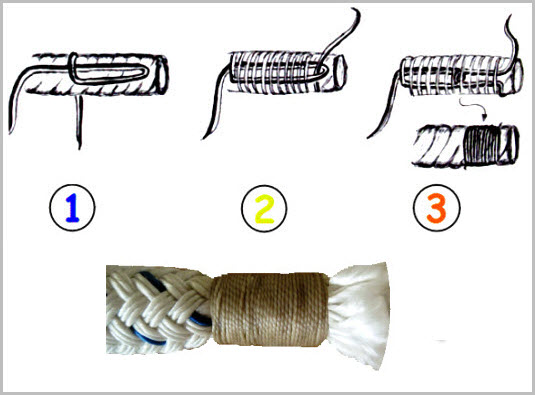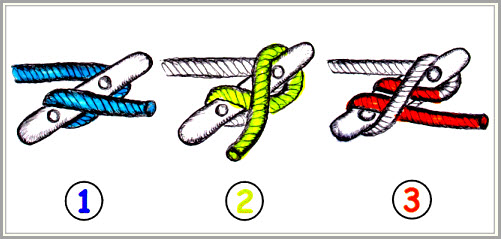Nautical Knots and Line Strength
| How Common Knots Reduce Line Strength | |||||||||||||||||||
| Type of Knot | Average Loss of Strength | ||||||||||||||||||
| Anchor Hitch | 25% | ||||||||||||||||||
| Round Turn and Two Half-Hitches | 30% | ||||||||||||||||||
| Bowline Knot | 35% | ||||||||||||||||||
| Clove Hitch | 40% | ||||||||||||||||||
| Becket (Sheet) Bend | 45% | ||||||||||||||||||
| Square (Reef) Knot | 55% | ||||||||||||||||||
Our favorite knots are:
Bowline: To attach sheets to sails, general purpose high strength
Sheet Bend: To join two ropes
Reef knots: To join two ropes
Clove Hitch: Attach fenders, etc. to railing or objects
Figure of Eight: at the end of sheets to prevent ropes passing through sheaves. We find this simpler knot does stays tied.
SEIZING

Seizing
Materials you will need:
- waxed sailmakers twine
- Beeswax cake
- duct or electrical tape
- sharp knife
1. Prepare the line Wrap a thick 1″ piece of duct or electrical tape near the bitter end. Cut through the middle of the tape with a sharp knife. This keeps the end from unraveling as you make the whipping.
2. Loop the sail twine Measure and cut 18″ to 24″ of sail twine. Run it through the beeswax cake to add a protective outside coating. Make a 1″ loop in one end of the twine. Position the loop as shown (illustration 1).
3. Whip toward the end Wind the long end of the twine around the line. Work up toward the bitter end. Pass the end of the twine through the loop (illustration 2).
4. Remove the slack Pull the twine to center the loop underneath the turns (third illustration – top). Twirl the ends of the twine around the fingertips of each hand. Pull outward at the same time to bury the strands and tighten the whipping (illustration 3).
5. Neaten the whipping Remove the tape from the end of the whipping. This leaves about 1/2″ of bitter end to extend past the whipped end. The expanded fibers will help keep the whipping in place.
CLEATS

Cleat







IMO the square (reef) knot should never be a load-bearing knot. The sheet bend is superior in all instances and the Carrick Bend even better.
The reef knot is great for reefing or for tying packages or shoes.
You’re quite correct Charles, the reef knot is a poor choice for taking on large loads. A weak knot that can slip. I use it to tie my rope belt.
We see your club trains young and old to sail, looks a treat on those lakes. I downloaded your club’s weather guide so nicely illustrating fronts, and of course saw that it’s backwards to Downunder. 🙂
Must be quite a number in the University of Wisconsin Sailing Club?